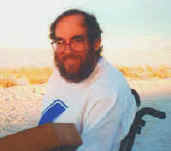





|
Our Shared History
by Steven Brown
Years ago rain poured and
pelted, Garbage bags served as hats and umbrellas
On a rainy day in 1989, I rolled from one of the buildings
near the United States Capitol to the White House. Several
hundred of us marched.
Where is George? We shouted, He who had spouted rights for us,
Where was he now in this fight for us?
The demonstration was planned early in the week at the
National Council on Independent Living annual meeting. Some
pundits had speculated that the recently elected George Bush
actually became President because of his courting of the
disability vote. But those of us in the trenches, the
advocates for an Americans with Disabilities Act, realized
that Bush had been silent on the matter since his Presidential
inauguration. “Where is George?” became the march
theme.
Marca sent us off, With rousing words, Hopes of glory, Regrets
in her story. Anger filled the air, Fleshed, Flushed, Flashed,
Blinding Lightning and Rolling Thunder
At the building where we gathered to begin the evening’s
candlelight vigil, NCIL’s President, Marca Bristo, greeted
us with an inspiring speech expressing fury because she couldn’t
go with her child to the park near their home because it was
inaccessible.
ADA now, We yelled. ADA now, We rebelled. Through the streets
of Washington from the Capitol to the dawn, when we got there
we spent our time tap-dancing on the White House Lawn
The ADA of 1989 is little remembered these days. After the
failure of the 1989 bill, advocates all over the country
accelerated our efforts to see ADA passed into law in 1990. On
the ten-year anniversary of its passage, I don’t have to
tell you we succeeded. Two events from that year still appeal
to my memory. I chose not to be at either one of them.
In the spring of 1990, ADAPT (then Americans with Disabilities
for Accessible Public Transportation) coordinated a march in
Washington and a crawl up the Capitol steps. I desperately
wanted to be there. I had the resources and the time to do
just that. But I also had another responsibility. I was Chair
of the Region VI CIL Director’s Coalition, which believed
that I should go to D.C. to speak with legislators. I knew
many others would be at the ADAPT march. I chose to go a few
weeks earlier when, as it turned out, a handful of us moved
door-to-door in Senate and House office buildings, educating
legislators about ADA.
George Bush signed the ADA into law, July 26, 1990. More
people attended that signing ceremony than any other signing
in history. I was invited. I wanted to go. Instead, I sat in a
meeting in Austin, Texas, because I made the commitment before
anyone knew the ADA signing date. I believed attending this
meeting in Austin was exactly what the ADA was all about:
participating in my daily planned activities just like any
nondisabled person. Ten years later the ADA is under attack.
That’s all we need to hear to know its still needed. |
|
To learn more about the history of ADA,
see Fred Pelka,
THE ABC-CLIO COMPANION TO DISABILITY RIGHTS (Santa Barbara: ABC-CLIO,
1997)
and
Joseph P. Shapiro,
NO PITY: PEOPLE WITH DISABILITIES FORGING A NEW CIVIL RIGHTS MOVEMENT
(New York: Times Books, 1993)
|
Poetry from the book PAIN, PLAIN - AND FANCY RAPPINGS: POETRY FROM THE DISABILITY CULTURE, Tap-Dancing on the White House Lawn by Steven E. Brown, copyright 1995 by The Institute on Disability Culture.
|
top of page |
|



